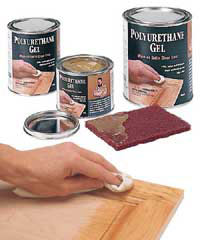
I have used this product for about the last 5 years and totally agree that it works great, it’s easy to use, and looks like a million bucks. However, I have only used it over a stain and my recent project — cabinet doors made of hard white maple — has me applying the gel polyurethane on natural wood. I am using the same method as I did when applying it over a stain and the results look totally different. After it dries, I can literally see lines in the varnish from wiping the polyurethane with a rag. I am using an old t-shirt (mostly cotton) to apply and another old t-shirt of the same material to then wipe it off. Am I using too little of the varnish when I put the coat on? Am I not wiping enough off when I wipe it off with the second rag? I tried a sponge and got the same results … lines in the finished look. Can you help me out with my method?
Michael Dresdner: Without having watched you, it is difficult to say what if anything was done wrong. However, you should have had no problem with gel polyurethane on maple. I will assume that you are using a clear gel, not a gel stain. I generally apply these gels by scrubbing them into the sanded wood with fine (gray) Scotchbrite”, then wiping it all off with those blue Scott paper shop towels. I use these because they are cheap enough that I am likely to wipe more cleanly, which is important. Using cloths, you are always tempted to make a more expensive cloth work past the point of absorbency, and with gels, I find that cloths get slimy pretty quickly. With the paper towels, I use several and make sure the gel is all wiped off uniformly. On a hard wood like maple, any uneven wiping is bound to show, and I suspect that is the problem here.






